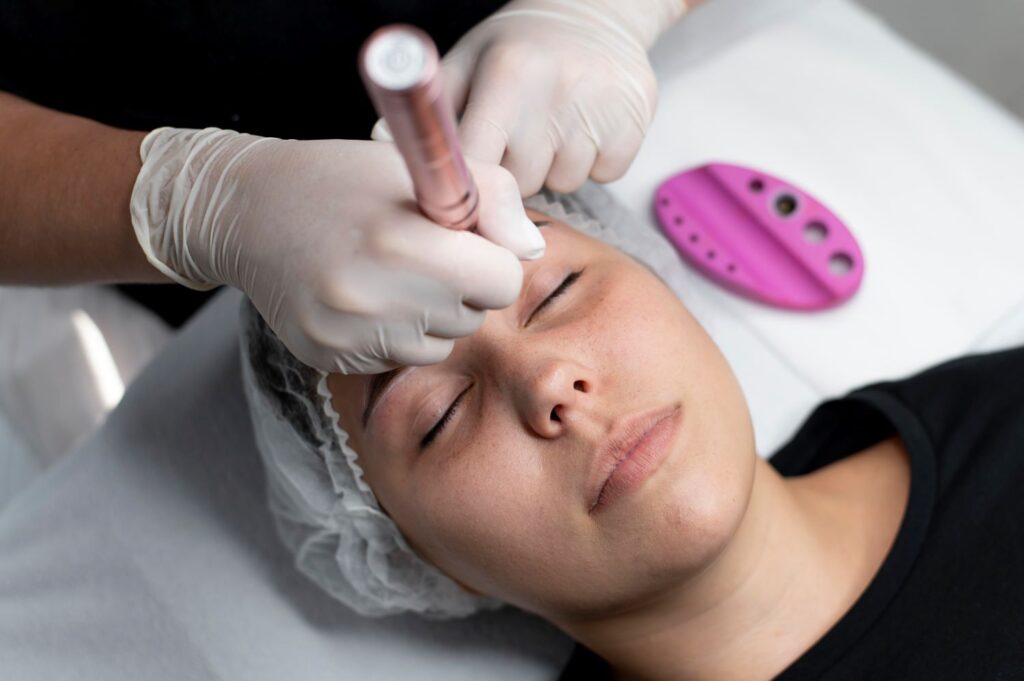
Derma pen microneedling also known by the names Percutaneous Collagen Induction (P.C.I.), Collagen Induction Therapy (C.I.T.), Scar Rejuvenation Therapy (S.R.T.), and Skin needling, is a highly effective skincare procedure that harnesses the body’s natural healing process to rejuvenate and enhance the skin. The origin of microneedling can be traced back to ancient times, where various cultures used rudimentary tools to puncture the skin for therapeutic purposes. However, the modern concept of microneedling, including the development of the Dermapen device, emerged in the early 2000s with advancements in technology and dermatological research. Dermapen microneedling has evolved into a widely recognized and respected treatment.
Using a specialized device with fine needles, Derma pen creates controlled micro-injuries in the skin’s surface, stimulating collagen and elastin production. This results in smoother texture, improved tone, and a more youthful appearance. Derma pen microneedling is versatile, addressing various Skin concerns.
Skin will be cleansed and prepped with a topical numbing cream to minimize discomfort during treatment.
Derma pen device is prepared by attaching a sterile disposable needle cartridge with fine needles of the
appropriate length for the treatment area.
Skincare professional will use a Derma pen device to create controlled micro-injuries in the skin’s surface.
During or immediately after microneedling, a specialized serum or skincare product may be applied to the
skin to help calm the skin and enhance healing.
Confused If two of them are the same? We have got you covered. While derma rollers and Dermapen microneedling share the goal of improving skin texture through controlled micro-injuries, derma rollers carry specific risks. Improper usage, such as applying excessive pressure or using longer needles, can lead to skin damage, including bruising, bleeding, and scarring. Additionally, inadequate sanitation of derma rollers increases the risk of infection. Derma rollers lack the precision and adjustable needle depths, potentially resulting in uneven treatment and suboptimal results. Therefore, while both methods have similar objectives, Dermapen microneedling, with its controlled electronic device and adjustable needle depths, is a much safer and more effective option.
The number of sessions needed depends on individual skin concerns and treatment goals. Generally, a series of sessions spaced several weeks apart is recommended for optimal results.
The procedure may cause some discomfort, but a topical numbing cream is typically applied before treatment to minimize any pain or discomfort. Most patients tolerate the procedure well.
Yes, Dermapen microneedling can be combined with other skincare treatments, such as chemical peels or laser therapy, to enhance results and address specific skin concerns.
Side effects are typically mild and temporary, including redness, swelling, and minor irritation. Serious complications are rare when the procedure is performed by a trained professional.
Immediately after Dermapen microneedling, the skin may appear slightly red and swollen, similar to a mild sunburn. However, the punctures created by the microneedles are typically very small and may not be visible to the naked eye. Any redness or swelling usually subsides within a few days, and most people can resume their normal activities with minimal downtime.
Before Dermapen microneedling, consult with a skincare professional, follow pre-treatment instructions, ensure clean skin, and post-treatment, adhere to care instructions after the treatment avoid sun exposure, and maintain gentle skincare practices for optimal results and minimal complications.